American Journal of Plant Sciences
Vol.3 No.4(2012), Article ID:18702,9 pages DOI:10.4236/ajps.2012.34057
Structure, Composition and Diversity of Horticulture Trees and Agricultural Crops Productivity under Traditional Agri-Horticulture System in Mid Hill Situation of Garhwal Himalaya, India
![]()
Faculty of Technical Forestry, Indian Institute of Forest Management (IIFM), Bhopal, India.
Email: arvind276@rediffmail.com
Received November 7th, 2011; revised November 29th, 2011; accepted December 20th, 2011
Keywords: Agri-Horticulture System; Biological Yield; Grain Yield; Northern Aspect; Southern Aspect
ABSTRACT
Productivity of agricultural crops under traditional agri-hortculture system alongwith structure, composition and diversity of fruit trees and shrub species in mid hill situation of Garhwal Himalaya, India between 1000 to 2000 m asl during summer and winter seasons on northern and southern aspect were studied. The tree density, composition and diversity in the system varied depending upon aspect, landholding and requirements of the farmers. A total of 12 fruit tree species were recorded in agri-horticulture system; of which 4 trees were common in northern and southern aspect and 6 trees were only noticed in northern aspect while 2 in the southern. The apple tree (Malus domestica) was recorded to be dominant fruit tree species with highest IVI values on both northern and southern aspect with prime preference by the farmers for high additional economic return in agri-horticulture system. Among the shrubs, the 6 shrub species were recorded on the northern aspect whereas there number was 16 on southern aspect. The agricultural crop diversity was higher on the northern aspect in summer and winter season. The average annual productivity of grain under agri-horticulture system recorded 1106 kg∙ha–1∙year–1 on northern aspect and 1122 kg∙ha–1∙year–1 on southern with a reduction of 34.56% and 38.29% compared to the sole agriculture crops. The aspect and season also played significantly role in grain, straw and biological productivity of agricultural crops present in agri-horticulture and sole cropping systems. In general there was reduction in yield of agricultural crops under fruit trees but this reduction is supplemented by fruit production which support and sustain the rural community of this hilly region.
1. Introduction
Cultivation of agricultural crop alonwith fruit trees (Agrihorticulture) is an exclusive and unique practice in the Garhwal Himalayan region of Uttarakhand, India. Fruit trees are planted and retained by the farmers as associate crops in the different places on agricultural fields of this region. The presence of trees also create hindrance during agricultural operation and on the agricultural productivity but their other benefits bound farmers to grow them in the suitable places. The status of natural regeneration of tree crop is very poor in the existing systems due to the deliberate removal of seedlings from the field during cultural and other operations. The Selection of intercrops depends mainly on edapho-climatic conditions of the area, farmer’s need/traditions and resource availability [1]. Among the horticultural trees, the Malus domestica, Prunus armeniaca, Citrus sinensis, Prunus domestica etc are very common in this region. The present study is an attempt to analyze the aspectwise study on structure and composition of trees in existing agri-horticulture system and their impact on agricultural yield in the Garhwal Himalayan region of Uttarakhand, India.
2. Materials and Methods
The study was carried out in the existing traditional agrihorticulture systems of selected villages in Chamba block of district Tehri Garhwal (Uttarakhand), India between 1000 to 2000 m asl elevation during rabi (NovemberMarch) and kharif (April-October) seasons in the year 2004-2006 (Figure 1). Geographically the area falls between sub-tropical to temperate zone, with majority of agricultural fields fall in high degree of terraced slopes, resulted soil and water losses. The traditional agricultural fields are dominated with luxuriant and green lush natural
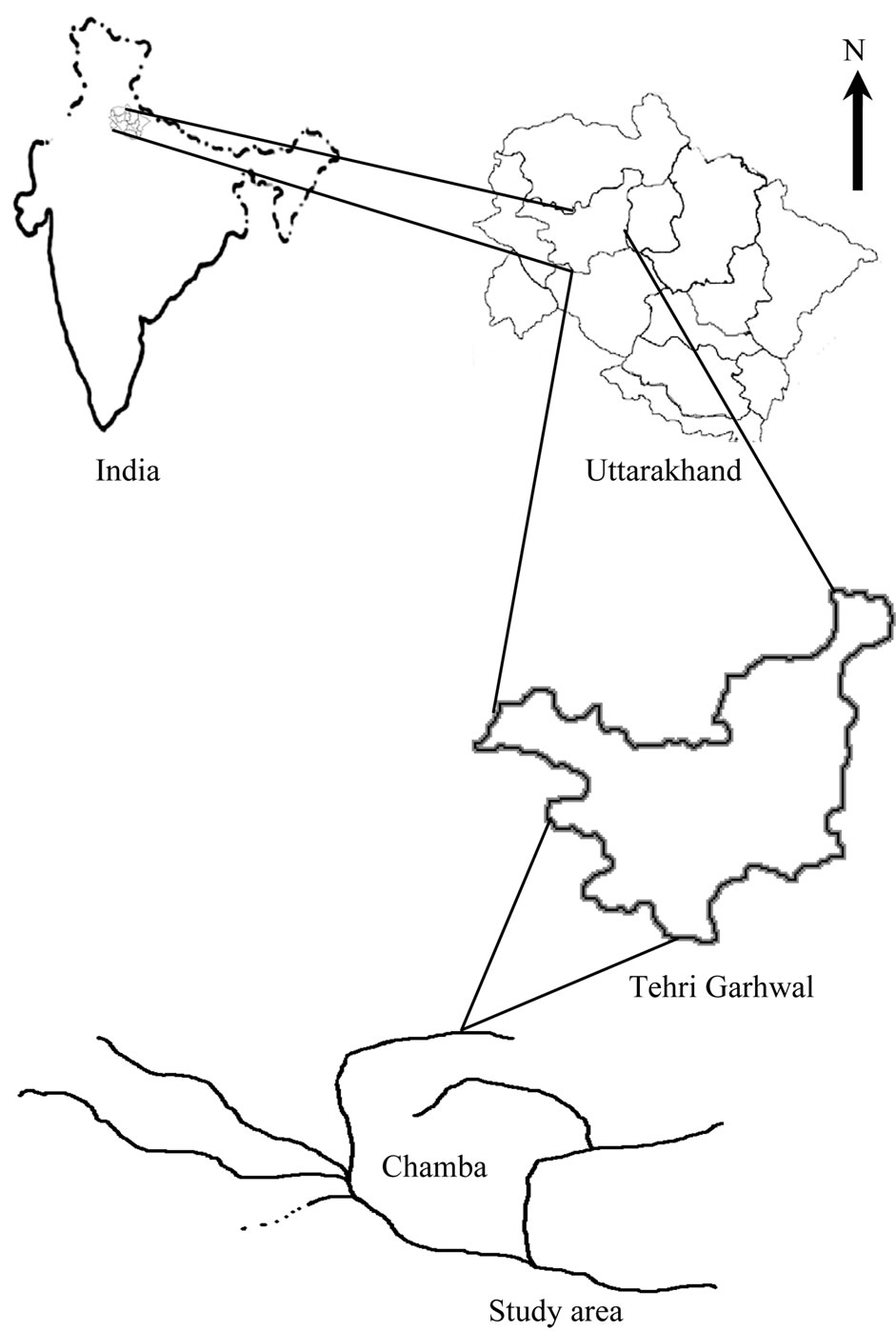
Figure 1. Location map of the study area.
vegetation. The soil of this region is acidic in nature varying in texture as per the availability of organic matter. Agricultural is the mainstay of livelihood of this region; about 85% of the villagers are engaged in agricultural interventions that too is low productive. The area receives an average annual rainfall of 1240 mm and most of the rain occurs during July to September (monsoon period). The mean annual temperature of the study area ranges from 9˚C to 33˚C with occurrence of snowfall during November to February. Though traditional agroforestry (agrisilviculture system) is also dominating in this region yet the farmers are inclined toward the horticulture trees on their agricultural fields (agri-horticulture system), due to appropriate climatic and geographical situation and more monitory return through this practice.
In the present study, 20 quadrats were laid in each site (northern and southern aspect) with 4 replication having sample size 10 × 10 meter for trees, 5 × 5 m for shrubs and 0.5 × 0.5 meter for agricultural crops. The productivity of different existing agriculture crops under fruit trees was estimated and compared with the productivity of sole agriculture (control). In the existing agri-horticulture system, the phytosociology comprises frequency, density, abundance, Total Basal Cover (TBC), Abundance/Frequency (A/F) ratio and Importance Value Index (IVI) of existing horticultural trees were analyzed in both northern and southern aspect. The quantitative analysis of frequency, density and abundance was done by using the standard expressions [2,3]. The A/F ratio was used to interpret the distribution pattern of the species [4]. The importance value index (IVI) was determined as the sum of relative frequency, relative density and relative dominance/basal area [2,3,5]. The diversity parameters of trees and shrubs were analyzed following [6], concentration of dominance [7], equitability [8], species richness [9] Beta diversity [10,11].
The assessment of productivity status of agricultural crops under agri-horticulture system was also estimated to understand the feasibility of the system. The samples of agriculture crops were taken from farmers’ fields in completely randomized design. The agriculture crops from the quadrats were harvested at the maturity stage from the agri-horticulture system as well as in sole agriculture system to estimate the effect in yield under agroforestry system as compared to pure/sole agriculture system. The mature agriculture crop was harvested and separated in grain (seeds) and straw (vegetative portion including shoots and leaves). Further, grain and straw were dried so as to obtain the net yield of crop (kg∙ha–1) on season basis (rabi and kharif season). The Harvest Index (HI) is used to denote the fraction of economically useful products of a plant in relation to its total productivity (grain to straw ratio) and calculated using following formula:
HI = (EY/BY) × 100
where: EY = Economic Yield (grain yield), BY = Biological Yield (grain + straw).
3. Results and Discussion
3.1. Structure and Composition (Phytosociology) of Fruit Trees
Agri-horticulture systems in the Garhwal Himalayan region are preferred by the farmers in order to produce fruits and crops from the same piece of land. The results regarding fruit trees and agricultural crops in agri-horticulture system of this study are presented hereafter. Table 1 shows the results on phytosociology of horticultural trees on the northern (site-N) and southern (site-S) aspects of the study area. Among the temperate fruit tree species in the northern aspect, the highest frequency (55%), density (1.55 trees 100 m–2), TBC (623.08 cm2 100 m–2) and IVI (63.65) values were recorded for Malus domestica, therefore this species was recorded to be dominant species (Table 1). The Prunus domestica was

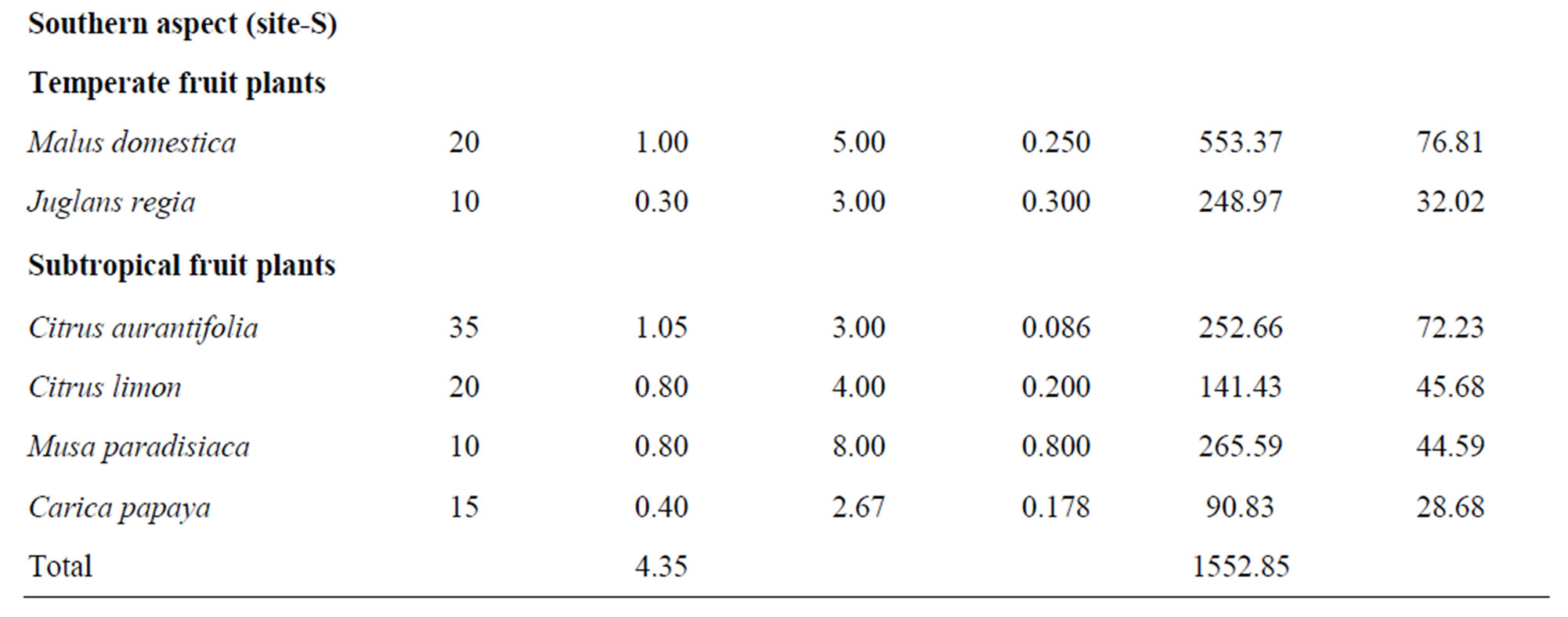
Table 1. Phytosociological (structure and composition) analysis of fruit tree layer in the agri-horticulture system.
recoded to be the co-dominant species in the temperate region of northern aspect with frequency (30%), density (0.80 trees 100 m–2), TBC (392.86 cm2 100 m–2) and IVI (36.01). The lower IVI values were recorded for Castanea sativa (10.84), Juglans regia (12.74) and Prunus persica (17.60) in the northern aspect of temperate fruits. The sub tropical fruits in the northern aspect showed with the higher IVI value (48.84) by Citrus sinensis and therefore dominated among the sub topical fruits. In the southern aspect the Malus domestica again dominated with higher IVI (76.81) in temperate fruits while the sub tropical fruits of the site were dominated by Citrus aurantifolia with IVI value as 72.23. In agri-horticulture systems, a total of 12 tree species were observed; of which 4 fruit trees were commonly found in northern and southern aspect (Malus domestica, Juglans regia, Citrus aurantifolia, Citrus limon) and 6 species only noticed in northern aspect (Prunus domestica, Prunus armeniaca, Pyrus communis, Prunus amygdalus, Prunus persica, Castanea sativa). The southern aspect possessed 2 new species (Musa paradisiacal, Carica papaya) as presented in Table 1.
Traditional agroforestry plays a fundamental role in livelihood support for the farmers of Garhwal Himalaya. The agriculture practices prevailed in the Garhwal Himalaya is rainfed in nature and low productive. The agricultural land is fragmented with terraced slopes constituting a fragile ecosystem leading to difficulty in agricultural operations and even not sufficient to meet out the annual demand of food grain of the household. The indigenous agroforestry practices are often diverse in their species composition yet climatic conditions are favourable for fruit trees and provide economic benefit to the farmers. Though the demand of fuel and fodder is prime importance by the farmers but that is met by the forest trees present on their farm in the form of agri-silviculture and the forests of adjoining areas. The agri-horticulture is a common practice by the farmers mostly having high land holding in order to produce fruits and crops from the same piece of land and to achieve more income. The apple tree (Malus domestica) was predominated in northern and southern aspect in agri-horticulture system of this region. The apple is the major fruit crop because it provides additional monetary benefits to farmers’ alongwith agricultural crops. It was also concluded; that on the sloppy land the sole agricultural practices were difficult; therefore, different agroforestry combinations were preferred by the farmers and horticultural trees were the priority by the farmers. It was observed that the fruit yield increased some times, when the fruit trees were grown in intercropping with agriculture, that could be attributed to the application of fertilizers for the growth and development of agricultural crops. The IVI values of trees in present investigation were in concurrence with the studies conducted in the traditional agroforestry systems in the Bilaspur and Raipur districts of Chhattisgarh region of India [12].
3.2. Phytosociology of Shrub Layer
The abundance of shrubs was also recorded in the agrihorticulture system in northern and southern aspect (Table 2). A total of 6 shrub species were recorded in northern aspect and 15 in the southern. In the northern aspect


Table 2. Phytosociological analysis of shrub layer in the agri-horticulture system.
the Eupatorium adenophorum was recorded as dominant species (IVI = 96.26) followed by Berberis asiatica (IVI = 64.72) and Rubus ellipticus (IVI = 44.65) while Rumex hastatus (IVI = 28.86) was the suppressed shrub species. The southern aspect showed more species diversity in shrubs with highest IVI (49.96) was recorded by Artemisia vulgaris followed by Eupatorium adenophorum (46.96) and least by Murraya koenigii (4.24) and therefore considered as dominant, co-dominant and suppressed shrub species in the southern aspect. In general Eupatorium adenophorum was recorded in the category of obnoxious weed (shrub) and thrived well in both northern and southern aspect (Table 2).
The higher shrub species were recorded on the southern aspect under agri-horticulture system. In a similar study [13] in Western Himalaya, reported that among different agroforestry systems, the horti-silvipastural system was more diversified, since it had as many as 12 trees, 4 shrubs, 7 herbs and 6 fruit species. Similar results had also been reported [14] in the Western Himalayan region of India under traditional agroforestry systems.
3.3. Diversity Indices of Fruit Trees and Shrubs
The data presented in Table 3 reveals that, Shannon index (diversity) values of trees was higher (0.933) on northern aspect as compared to southern aspect (0.704) under agri-horticulture system. Contrary to this, the Simpson index (concentration of dominance) values of trees were found to be highest (0.229) on southern aspect. The higher species richness value (1.321) was recorded in northern aspect. The slightly higher equitability (0.393) was observed in southern aspect of agri-horticulture systems. Beta diversity was higher (2.667) on southern aspect while it was lower (1.455) on northern aspect of agri-horticulture system. Among the shrubs the higher diversity (1.058) and species richness (3.065) was observed in the southern aspect whereas higher Simpson Index (0.186), equitability (0.418) and beta diversity (2.833) was recorded in northern aspect (Table 3).
The tree diversity and species richness was higher on northern aspect as compared to southern aspect under agri-horticulture system whereas concentration of tree species was found to be higher on southern aspect. In contrarily the shrubs occupied higher diversity and species richness in the present study on the southern aspect under agri-horticulture system (Table 3). The diversity parameters of these agroforestry systems are comparable with the diversity indices reported by different workers for other regions in agroforestry and non-agroforestry systems [12,14-16]. In an experiment [17] reported the Shannon-Weaver index (Diversity) values from 0.41 to 2.31, concentration of dominance from 0.38 to 1.00 in the Thar desert under natural silvipastoral system which are higher than the present study. The Simpson Index for the home garden of Kerala in South India varied 0.44 to 0.86 [18,19] which is quite high than the present study. In the present study, the higher diversity values on northern aspects may be due to the higher moisture content and low insolation rates as compared to southern aspects, which receive the Sun rays in later part of the day, when the atmosphere is sufficiently warmed. The effect of aspect on structure and diversity of vegetation was also quantified by several workers [20-22]. The higher tree diversity in northern aspect was attributed to the presence of higher number of species (21), while the higher concentration of dominance in southern aspect, was due to the high relative proportion of few fruit species in these systems. The higher beta diversity in the southern aspect represented the higher niche diversification compared to northern aspect under agri-horticulture system. The lower number of shrubs was found on northern aspect which might be due to higher slope in northern aspect under agri-horticulture systems. The tree canopy cover was higher on the northern aspect, which interrupted the growth and development of shrubs and may be another reason for the lower occurrence of shrubs.
3.4. Productivity of Agricultural Crops
The annual agriculture productivity under agri-horticulture system for summer and winter (kharif + rabi), when compared with control/sole agriculture system, a significant difference in productivity of agricultural crops was observed (Table 4). The productivity of agricultural crops includes three components viz. 1) productivity of grain or seeds (also referred to as economic productivity); 2) straw productivity, which includes other than the grain (shoot and leaves); 3) biological productivity or total productivity (includes grain and straw both).

Table 3. Aspect wise diversity in agri-horticulture system.
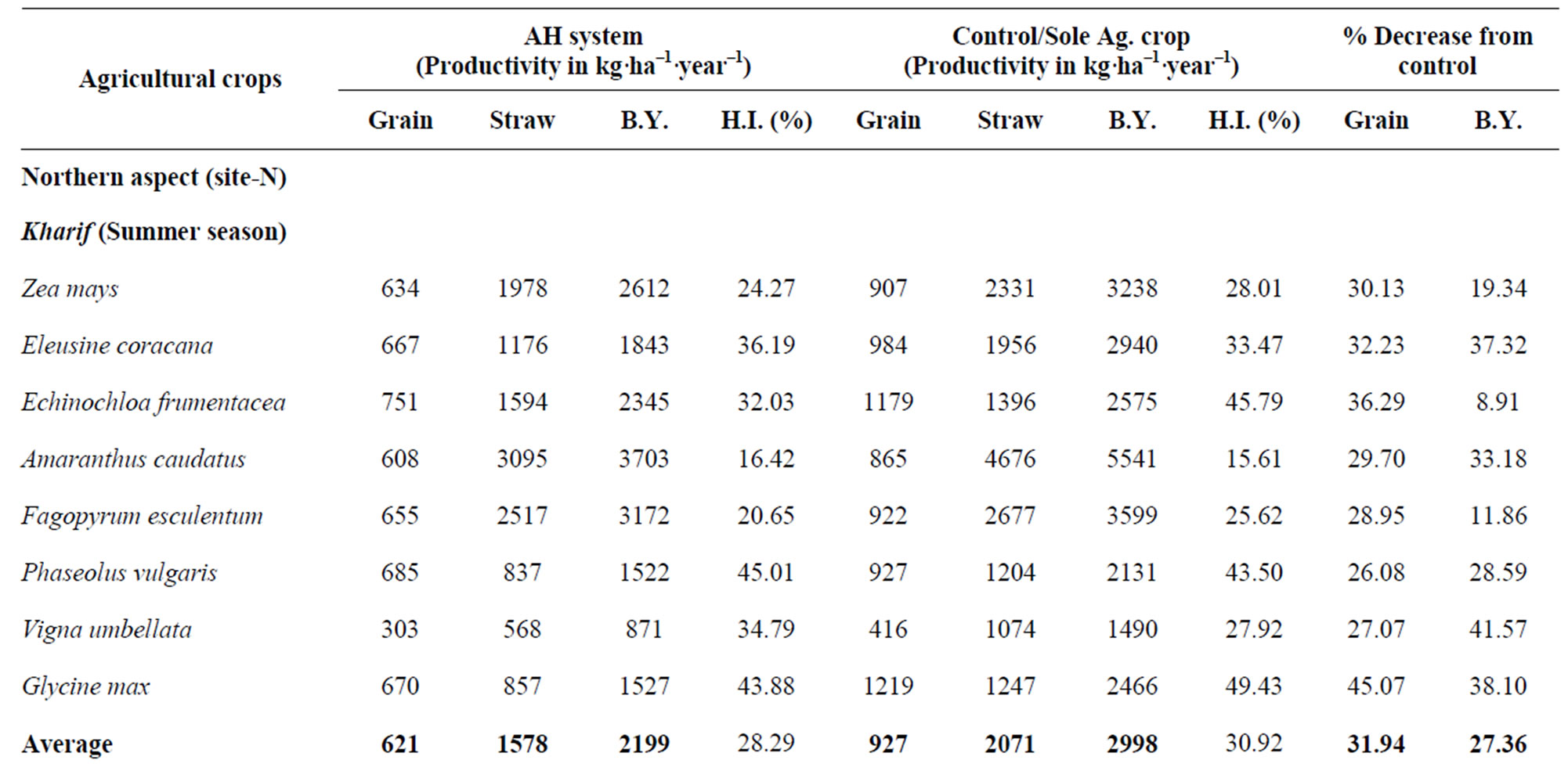
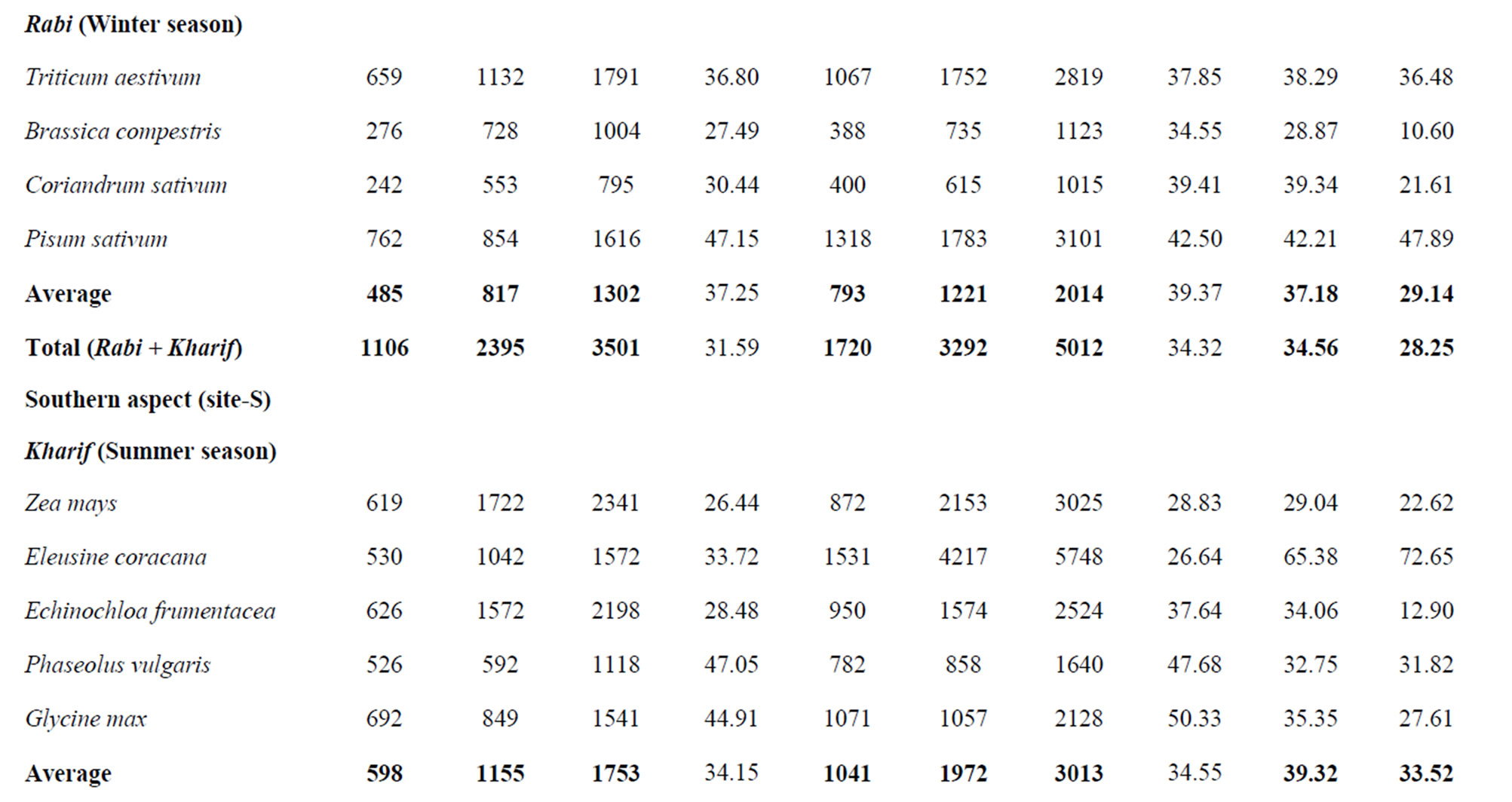

Table 4. Productivity of Agriculture crops (kg∙ha–1∙year–1) under agri-horticulture system.
3.5. Productivity of Grains (Economic Yield)
Data presented in Table 4 shows the annual (summer and winter) economic yield of agriculture crops under agrihorticulture system as 1106 kg∙ha–1∙year–1 on northern site with a reduction of 34.56% compared to the sole agriculture crops (1720 kg∙ha–1∙year–1). The grain yield was recorded 621 kg∙ha–1∙year–1 and 485 kg∙ha–1∙year–1 in summer and winter season respectively. The Harvest Index varied from 16.42% (Amaranthus caudatus) to 45.01% (Phaseolus vulgaris) in summer season and 27.49 (Brassica compestris) to 47.15 (Pisum sativum) in winter season in northern aspect under agri-horticulture system. In the southern aspect the annual economic yield of agricultural crops under agrihorticultural system recorded 1122 kg∙ha–1∙year–1 compared to 1859 kg∙ha–1∙ year–1 in sole agriculture system. There was 38.29% reduction in the grain yield under agrihorticulture system compared to sole agriculture. The Harvest Index in the southern aspect varied from 26.44 (Zea mays) to 47.05 (Phaseolus vulgaris) in summer and 24.94 (Coriandrum sativum) to 47.37 (Pisum sativum) winter season under AH system. The northern aspect was recorded to have 1.42% reduction in the grain yield compared to southern (Table 4).
The productivity of grain under agri-horticulture system was significantly reduced as compared to sole agriculture system. The grain yield was slightly retarded (1.42%) on the northern aspect compared to southern; moreover, within the aspect, the summer and winter seasons have also recorded significant difference in grain yield. In general the higher vegetation was found on the northern aspect on the hills compared to southern. Though there was a slight reduction in the average grain yield under agri-horticulture and sole cropping on the northern aspect of the present study, but the single cropwise productivity is quite high on the northern aspect. The agricultural crop diversity (number of agricultural crops) was higher on the northern aspect and also included some light crops like Vigna umbellata (303 kg∙ ha–1∙year–1) and Brassica compestris (276 kg∙ha–1∙year–1) on the northern aspect which were completely absent on the southern aspect. This might have also reduced the average yield on the northern aspect compared to southern. In the present study, the reduction of grain yield under agri-horticulture system was in conformity with the other findings [23], who had also recorded poor performance of soybean crop under tree species. The studies [24] on tree-crop interaction under Morus alba and Eucalyptus with rice and wheat cropping systems showed that all tree species had adverse effect on crop yield. It was observed that the crop yield increased with an increase of crop distance from the tree [25]. Overall, the reduction in the yield of intercrops due to presence of trees may be attributed to differential patterns of canopy spread, resulting in variation in light interception, severe competitions of the tree roots for moisture and shade effects. The study carried [26] showed that the grain yield of pure crops was higher as compared to the grain yield from the tree-crop systems. In the agri-horticulture system, the agricultural crop production is generally lower due to competition with trees, but the fruit yield is adequately compensated due to overall productivity (tree + crop), which is generally greater than sole agriculture system [26]. A study conducted in agroforestry systems [27] found that a significant grain yield losses of Cowpea (Vigna unguiculata) up to 21% and pearl millet (Pennisetum glaucum) up to 67% was observed under trees compared to outside in south-central Burkina Faso. Moreover, the lower variations in the intercropped can be attributed to lower population of crop in the intercrop. The results of the present study is also justified by [28] who revealed that the grain yield was found to be 61.10% to 51.23% of the control below Eucalyptus tereticornis canopies and 80.57% to 71.58% of the control below Dalbergia sissoo canopies.
3.6. Biological Productivity (Grain and Straw)
The biological productivity of agricultural crop under agri-horticulture system was recorded as 3501 kg∙ha–1∙ year–1 compared to 5052 3344 kg∙ha–1∙year–1 in sole agricultural system on the northern aspect and therefore, there was a reduction of 28.25% in the biological yield under agri-horticulture system (Table 4). In the southern aspect the biological yield was noticed 3344 kg∙ha–1∙ year–1 under agri-horticulture system while the sole crop yielded 5072 kg∙ha–1∙year–1, there was 28.82% reduction in biological in this aspect. The 4.48% reduction was observed in the biological yield under southern aspect as compared to northern under agri-horticulture system whereas in sole agriculture system the biological yield was 1.20% higher in southern aspect (Table 4). The maximum reduction in the biological yield was observed in Vigna umbellata (44.57%) during summer and Pisum sativum (47.89%) during winter on the northern aspect compared to crops grown without tree. In the southern aspect the maximum reduction in biological yield was noticed in Eleusine coracana (72.65%) during summer and Coriandrum sativum (28.53%) during winter compared to sole agricultural crop (Table 4).
The straw yield was comparatively low under agroforestry systems, as compared to sole agriculture system. The higher grain yield in the sole cropping systems was attributed to the availability of high PAR (Photosynthetic Active Radiation), which helped in more reproductive phase development [29]. Similarly reduction in biological yield was also found 61.63% to 56.02% of the control under Eucalyptus tereticornis and 72.02% to 69.16% of the control under Dalbergia sissoo [28]. The Harvest index clearly indicated the grain to straw ratio. The higher Harvest Index of crop in sole agriculture clearly stated that the proportion of development of grain was higher in sole agriculture system, whereas relatively more straw was developed the crop cultivated under agrihorticulture system (Figure 2). The biological yield of agricultural crop under agri-horticulture system was also lowered down compared to sole agricultural system. The reduction in the biological yield under southern aspect was also observed under agri-horticulture system whereas in sole agriculture system the biological yield was 1.20% higher in southern aspect (Table 4). The reduction in crop yield under agri-horticulture system was mainly due to competition for the light, water, nutrients, allelopathic effect etc. The competition may be interspecific or intraspecific [30]. Shading was found to be more important than below ground competition in an intercropping study of pearl millet and groundnut in India [31]. Though there was a slight reduction in the average biological yield in sole cropping on the northern aspect of the present study, but the biological yield of each crop was reasonably high on the northern aspect. This could be due to higher agricultural crop diversity on the northern aspect that also
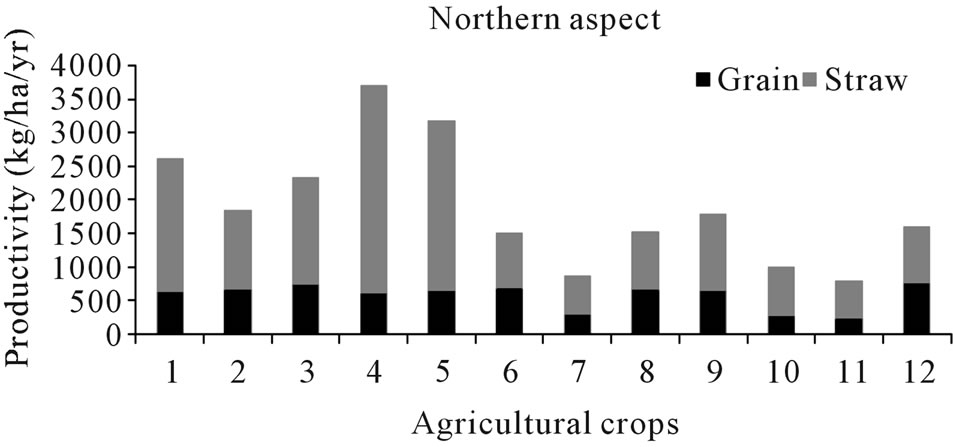
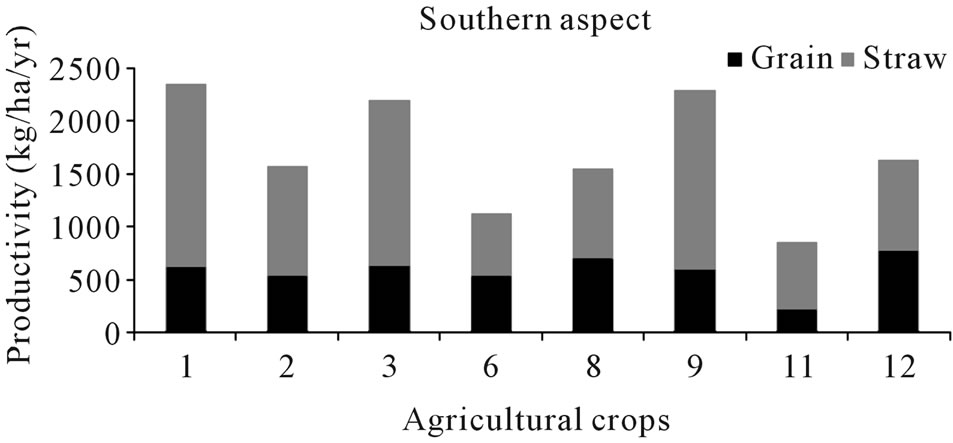
Figure 2. Grain to straw ratio under agri-horticulture system on northern and southern aspect. Agricultural crops: 1: Zea mays; 2: Eleusine coracana; 3: Echinochloa frumentacea; 4: Amaranthus caudatus; 5: Fagopyrum esculentum; 6: Phaseolus vulgaris; 7: Vigna umbellate; 8: Glycine max; 9: Triticum aestivum; 10:Brassica compestris; 11: Coriandrum sativum; 12: Pisum sativum.
included low biological yield of some light crops like Vigna umbellata (1490 kg∙ha–1∙year–1) and Brassica compestris (1123 kg∙ha–1∙year–1) in sole cropping on the northern aspect which were completely absent on the southern aspect. In general the productivity of agricultural crops was significantly impacted in open and shade condition beside aspect and season.
4. Conclusion
Agroforestry is a common practice in the mid hill situation of Garhwal Himalaya. Farmers are inclined toward retention of fruit based tree on their agricultural fields for additional monitory gain from the fruits and therefore agri-horticultural practice is the priority of high land holding farmers as the climatic and geographical situation also permit such practices. The aspect played a significant role in fruit tree density and diversity. Moreover, the reduction in the crop productivity under agri-horticulture compared to sole agriculture is compensated with fruit yields. The northern aspect possessed high tree density and diversity. The single crop yield was also higher on the northern aspect compared to southern. The apple tree (Malus domestica) is dominating in the agri-horticulture system of this region that revealed the social desire for this important species. The study concludes that there is a significant reduction of agricultural productivity (grain, straw and biological yield) under trees as compared to sole agricultural systems but the overall return from the tree-crop combination is higher. Therefore, the agri-horticultural based cropping patterns needs to be strengthened in this Garhwal Himalayan region.
5. Acknowledgements
The author is thankful to the Director, Indian Institute of Forest Management, Bhopal, India for encouragement and constant support to research activities. The help extended by the farmers of the study area are duly acknowledged.
REFERENCES
- P. L. Saroj and K. S. Dadhwal, “Present Status and Future Scope of Mango Based Agroforestry Systems in India,” Indian Journal of Soil Conservation, Vol. 25, No. 2, 1997, pp. 118-127.
- J. T. Curtis and R. P. Mc Intosh, “The Interrelationship of Certain Analytic and Synthetic Phytosociological Characters,” Ecology, Vol. 31, 1950, pp. 434-455. doi:10.2307/1931497
- E. A. Phillips, “Methods of Vegetation Study,” A Holt Dryden Book Henry Hold & Co., Inc., New York, 1959.
- P. B. Whitford, “Distribution of Woodland Plants in Relation to Succession and Clonal Growth,” Ecology, Vol. 30, No. 2, 1949, pp. 199-208. doi:10.2307/1931186
- J. T. Curtis, “The Vegetation of Wiscosin: An Ordination of Plant Communities,” University of Wisconsin Press, Madison, 1959.
- C. Shannan and W. Weaver, “The Mathematical Theory of Communication,” University of Illinois Press, Urbana, 1963.
- E. H. Simpson, “Measurement of Diversity,” Nature, Vol. 163, No. 4148, 1949, p. 688. doi:10.1038/163688a0
- E. C. Pielou, “Ecological Diversity,” John Wiley and Sons, New York, 1975.
- D. R. Margalef, “Information Theory in Ecology,” Yearbook of the Society for General Systems Research, Vol. 3, 1958, pp. 36-71.
- R. H. Whittaker, “Evolution and Measurement of Species Diversity,” Taxon, Vol. 21, No. 2/3, 1972, pp. 213-251. doi:10.2307/1218190
- R. H. Whittaker, “Evolution of Species Diversity in Land Communities,” In: M. K. Hecht, W. C. Streere and B. Wallace, Eds., Evolutionary Biology, Vol. 10, Plenum, New York, 1977, pp. 1-67.
- S. B. Sharma, S. Pandry, S. D. Upadhyaya and R. Agrawal, “Phyto-Sociological Studies of Tree Species Outside Forest in Traditional Agroforestry of Chhattisgarh,” Indian Journal of Agroforestry, Vol. 8, No. 1, 2006, pp. 26-34.
- N. S. Thakur, N. K. Gupta and B. Gupta, “Phytosociological Analysis of Woody and Non-Woody Components under Some Agroforestry Systems in Western Himalaya—A Case Study,” Indian Journal of Agroforestry, Vol. 6, No. 1, 2004, pp. 65-71.
- O. P. Toky, P. Kumar and P. K. Khosla, “Structure and Function of Traditional Agroforestry Systems in the Western Himalaya. I. Biomass and Productivity,” Agroforestry Systems, Vol. 9, No. 1, 1989, pp. 47-70. doi:10.1007/BF00120155
- P. K. Ralhan, A. K. Saxena and J. S. Singh, “An Analysis of Forest Vegetation at and around Nainital in Kumaun Himalaya,” Proceedings of Indian National Science Academy, Vol. 48, 1982, pp. 121-137.
- L. Singh and J. S. Singh, “Species Structure, Dry Matter Dynamics and Carbon Flux of a Dry Tropical Forest in India,” Annals of Botany, Vol. 68, No. 3, 1991, pp. 263-273.
- J. C. Tewari, M. D. Bohra and L. N. Harsh, “Structure and Production Function of Traditional Extensive Agroforestry Systems and Scope of Intensive Agroforestry in Thar Desert,” Indian Journal of Agroforestry, Vol. 1, No. 1, 1999, pp. 81-94.
- B. M. Kumar, G. S. Jacob and S. Chinnamani, “Diversity, Structure and Standing Stock of Wood in the Homegardens of Kerala in Peninsular India,” Agroforestry Systems, Vol. 25, No. 3, 1994, pp. 243-262. doi:10.1007/BF00707463
- D. Jose, “Structure and Productivity of the Homegardens of Kerala: A Case Study,” In: C. G. R. Ramachandran Nair, Ed., Proceedings of the Fourth Kerala Science Congress, Thrissure, Science, Technology and Environment Department of Kerala, Thiruvananthapura, 27-29 February 1992, pp. 17-19.
- N. K. Joshi and S. C. Tiwari, “Phytosociological Analysis of Woody Vegetation along an Altitudinal Gradation in Garhwal Himalaya,” Indian Journal of Forestry, Vol. 13, No. 4, 1990, pp. 322-328.
- R. Singh, U. K. Sood, M. Bhatia and G. C. Thakur, “Phytosociological Studies on Tree Vegetation around Shimla, Himanchal Pradesh,” Indian Journal of Forestry, Vol. 14, No. 3, 1991, pp. 169-180.
- S. K. Jha, “On Upper Bias in Forest Cover Data of Hilly Terrain Obtained through Satellite Imagery with Special Reference to Mizoram,” Indian Forester, Vol. 127, No. 8, 2001, pp. 871-878.
- S. K. Sharma and S. K. Chauhan, “Performance of Soybean Crop under Tree Species,” Indian Journal of Agroforestry, Vol. 5, 2003, pp. 137-139.
- M. L. Khybri, R. K. Gupta, S. Ram and H. P. S. Tomar, “Crop Yields of Rice and Wheat Grown in Rotation as Intercrops with 3 Tree Species in the Outer Hills of Western Himalaya,” Agroforestry Systems, Vol. 17, No. 3, 1992, pp. 193-204. doi:10.1007/BF00054147
- K. K Sharma, P. Khanna and A. Gulati, “The Growth and Yield of Wheat and Paddy as Influenced by Dalbergia sissoo Roxb. Boundary Plantation,” Indian Forester, Vol. 122, No. 12, 1996, pp. 114-126.
- R. Newaj, M. K. Bhargava, R. S. Yadav and A. K. Shanker, “Tree-Crop Interaction in Albizia procera Based Agroforestry System in Relation to Soil Moisture, Light and Nutrients,” Indian Journal of Agroforestry, Vol. 5, 2003, pp. 17-29.
- A. N. Osman, A. Rabild, J. L. Christiansen and J. Bayala, “Performance of Cowpea (Vigna nguiculata) and Pearl Millet (Pennisetum glaucum) Intercropped under Parkia biglobosa in an Agroforestry System in Burkina Faso,” African Journal of Agricultural Research, Vol. 6, No. 4, 2011, pp. 882-891.
- R. Kiran, A. K. Agnihotri and B. C. Saini, “Wheat Yield as Influenced by Net Radiation Available Below Eucalyptus tereticornis and Dalbergia sissoo Canopies,” Indian Journal of Agricultural Research, Vol. 36, No. 1, 2002, pp. 68-70.
- J. G. Bellow, “Fruit-Tree-Based Agroforestry in the Western Highlands of Guatemala: An Evaluation of Tree-Crop Interactions and Socioeconomic Characteristics,” Ph.D. Thesis, Graduate School of the University of Florida, Gainesville, 2004.
- J. H. Carnell, “Apparent versus Real’ Competition in Plants,” In: G. B. Grace and D. Tilman, Eds., Perspective on Plant Competition, Academic Press, New York, 1990, pp. 9-26.
- R. W. Willey and M. S. Reddy, “A Field Technique for Separating above and below Ground Interaction in Intercropping: An Experiment with Pearl Millet/Groundnut,” Experimental Agriculture, Vol. 17, 1981, pp. 257-264. doi:10.1017/S0014479700011613

